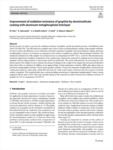

PARTNER
검증된 파트너 제휴사 자료
Improvement of oxidation resistance of graphite by aluminosilicate coating with aluminum metaphosphate interlayer
14 페이지
최초등록일 2023.12.18
최종저작일
2023.12

-
 * 본 문서는 배포용으로 복사 및 편집이 불가합니다.
* 본 문서는 배포용으로 복사 및 편집이 불가합니다.
미리보기
서지정보
· 발행기관 : 한국탄소학회
· 수록지 정보 : Carbon letters / 33권 / 7호
· 저자명 : M. Fekri, K. Jafarzadeh, S. A. Khalife Soltani, Z. Valefi, H. Mazhari Abbasi
목차
Improvement of oxidation resistance of graphite by aluminosilicate coating with aluminum metaphosphate interlayer
Abstract
1 Introduction
2 Experimental procedure
3 Results and discussion
3.1 Characterization of aluminum electrophosphate coating
3.1.1 Mechanism of aluminum metaphosphate coating formation
3.2 Characterization of aluminosilicate coating
3.2.1 Weight change of the samples after coating with the slurry
3.2.2 Microstructural analysis of the aluminosilicate coating
3.3 Investigation of the oxidation behavior
3.3.1 Phase characterization and microstructure of the oxide layer
3.3.2 Microstructure and chemical composition of the coating
4 Conclusion
References영어초록
In this research, in order to increase the oxidation resistance of graphite, kaolin and alumina powder with different ratios (26A-74S, 49A-51S, 72A-28S) and slurry method were used to create an aluminosilicate coating on the graphite substrate. In order to reduce the difference in the coefficients of thermal expansion of graphite with aluminosilicate coating, aluminum metaphosphate coating as an interlayer was prepared on the surface of graphite by cathodic electrochemical treatment. The isothermal oxidation test of the samples was carried out in air at a temperature of 1250 °C for 1, 3 and 5 h. The microstructure, chemical composition, and phase components of the coating were, respectively, analyzed by scanning electron microscope equipped with an energy-dispersive spectrometer and X-ray diffraction. The results indicated that, by increasing the withdrawal speed of the samples in slurry method, the amount of changes in the weight of the samples has increased and therefore had a direct effect on oxidation. In addition, it was approved that, at high-temperature oxidation, AlPO4 glass phase forms on aluminum metaphosphate interlayer which retards graphite oxidation. Along with aluminum metaphosphate, aluminosilicate coating also produces a glass phase which fills and seals the voids on the surface which prevents the oxygen to reach the surface of graphite. The created double-layer coating including an interlayer of aluminum metaphosphate + slurry coating prepared with the ratio of 26A-74S as the optimal coating in this research was able to increase the oxidation resistance of graphite by 73% at a temperature of 1250 °C.참고자료
· 없음태그
-
자료후기
-
자주묻는질문의 답변을 확인해 주세요

꼭 알아주세요
-
본 학술논문은 (주)코리아스칼라와 각 학회간에 저작권계약이 체결된 것으로 AgentSoft가 제공 하고 있습니다.
본 저작물을 불법적으로 이용시는 법적인 제재가 가해질 수 있습니다. -
해피캠퍼스는 구매자와 판매자 모두가 만족하는 서비스가 되도록 노력하고 있으며, 아래의 4가지 자료환불 조건을 꼭 확인해주시기 바랍니다.
파일오류 중복자료 저작권 없음 설명과 실제 내용 불일치 파일의 다운로드가 제대로 되지 않거나 파일형식에 맞는 프로그램으로 정상 작동하지 않는 경우 다른 자료와 70% 이상 내용이 일치하는 경우 (중복임을 확인할 수 있는 근거 필요함) 인터넷의 다른 사이트, 연구기관, 학교, 서적 등의 자료를 도용한 경우 자료의 설명과 실제 자료의 내용이 일치하지 않는 경우
“Carbon letters”의 다른 논문도 확인해 보세요!
-
Interdependent factors influencing the carbon yield, structure, and CO.. 13 페이지
-
Experiment and molecular simulation for liquid phase adsorption of tri.. 15 페이지
-
Black phosphorus nanosheets‑based effective electrochemical sensor for.. 9 페이지
-
Preparation and effect evaluation of rigid polyurethane flame retardan.. 9 페이지
-
Fabrication of graphene‑assisted voltammetry platform for the detectio.. 10 페이지
문서 초안을 생성해주는 EasyAI
